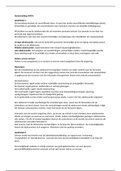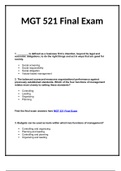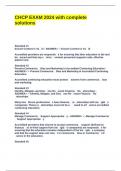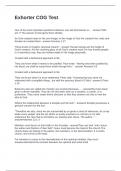ORGANIZATIONAL PSYCHOLOGY:
WORKING MAN
1.7 C
JIM LEFERINK OP REININK
ERASMUS UNIVERSITY ROTTERDAM
Psychology, Ba-1, 2017-2018
,TABLE OF CONTENTS
PROBLEM 1: WHAT DRIVES THEM? ....................................................................................................... 2
FIGURES .................................................................................................................................................................2
PROBLEM 2: SELECTIVE SELECTION .................................................................................................... 8
FOUNDATIONS OF PERSONNEL SELECTION .....................................................................................................................8
PERSONNEL SELECTION METHODS ............................................................................................................................ 12
REVIEW ARTICLE: THE EMPLOYMENT INTERVIEW (JUDGE ET AL., 2000) .......................................................................... 21
REVIEW ARTICLE: PERSONNEL SELECTION (ROBERTSON & SMITH, 2001) ........................................................................ 24
REVIEW ARTICLE: ADVERSE IMPACT IN PERSONNEL SELECTION (HOUGH ET AL., 2001) ...................................................... 24
PROBLEM 3: WHO'S THE BOSS? .......................................................................................................... 26
SOURCES OF INFLUENCE AND POWER ........................................................................................................................ 26
LEADERSHIP THEORIES ............................................................................................................................................ 28
PROBLEM 4: TROUBLE .......................................................................................................................... 37
BOOK CHAPTER: CONFLICT (MCKENNA, 2012) .......................................................................................................... 37
REVIEW ARTICLE: WORKPLACE BULLYING (SAMNANI & SINGH, 2012) ........................................................................... 44
PROBLEM 5: WHAT WORKS BEST? ..................................................................................................... 48
JOB SATISFACTION AND ITS MEASUREMENT SCALES ..................................................................................................... 48
ANTECEDENTS OF JOB SATISFACTION......................................................................................................................... 50
POTENTIAL EFFECTS OF JOB SATISFACTION ................................................................................................................. 54
ORGANIZATIONAL COMMITMENT ............................................................................................................................. 57
ARTICLE: COHEN (1992) ........................................................................................................................................ 60
REVIEW ARTICLE: JOB SATISFACTION AND JOB PERFORMANCE (JUDGE ET AL., 2001) ........................................................ 60
PROBLEM 6: OVERWORKED ................................................................................................................. 61
FIGURES .............................................................................................................................................................. 61
REVIEW ARTICLE: BURNOUT AND WORK ENGAGEMENT (BAKKER ET AL., 2014) ............................................................... 67
BOOK CHAPTER: DEMAND/CONTROL MODEL (KARASEK, 1998) ................................................................................... 71
BOOK CHAPTER: THE DEMAND-CONTROL-SUPPORT MODEL (DANIELS ET AL., 2014) ....................................................... 73
1
,PROBLEM 1: WHAT DRIVES THEM?
FIGURES
Motivation is a person’s reason for doing something. Clearly, then, motivation concerns the factors that push
us or pull us to behave in certain ways. Specifically, it is made up of three components:
• Direction: what a person is trying to do.
• Effort: how hard a person is trying.
• Persistence: how long a person continues trying.
It is important to remember that motivation is not the only factor that influences work performance; for
example, factors such as ability, quality of equipment, and coordination of team members’ efforts may also
affect performance at work.
One often-made distinction is between content theories and process theories of motivation.
• Content theories focus on what motivates human behaviour at work.
• Process theories concentrate on how the content of motivation influences behaviour.
Common-sense views of motivation contradict each other but all have some truth. There are three general broad
common-sense approaches to motivation which are endorsed by different individuals at different times:
• Theory X: People cannot be trusted. They are irrational, unreliable and inherently lazy. They therefore
need to be controlled and motivated using financial incentives and threats of punishment. In the
absence of such controls, people will pursue their own goals, which are invariably in conflict with those
of their work organisation.
2
, • Theory Y: People seek independence, self-development and creativity in their work. They can see
further than immediate circumstances and are able to adapt to new ones. They are fundamentally
moral and responsible beings who, if treated as such, will strive for the good of their work organisation.
• Social: A person’s behaviour is influenced most fundamentally by social interactions, which can
determine his or her sense of identity and belonging at work. People seek meaningful social
relationships at work. They are responsive to the expectations of people around them, often more so
than to financial incentives.
Need theories are based on the idea that there are psychological needs, probably of biological origin, that lie
behind human behaviour. When our needs are unmet, we experience tension or disequilibrium which we try to
put right. In other words, we behave in ways that satisfy our needs. Need theories are often thought of as
examples of content theories because of their emphasis on describing needs.
The humanistically orientated psychologist Abraham Maslow (1954) proposed five classes of human need:
1. Psychological: need for food, drink, sex, etc., i.e. the most primitive and fundamental biological needs.
2. Safety: need for physical and psychological safety, i.e. a predictable and non-threatening environment.
3. Belongingness: need to feel a sense of attachment to another person or group of persons.
4. Esteem: need to feel valued and respected, by self and significant people.
5. Self-actualisation: need to fulfil one’s potential – to develop one’s capacities and express them.
Alderfer (1972) proposed three classes of need: existence, relatedness, and growth. Existence equated to
Maslow’s physiological and safety needs. Relatedness can be matched to belongingness and the esteem of
others. Growth is equivalent to self-esteem and self-actualisation.
3





